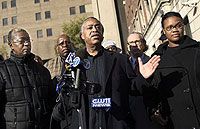Advertisement
November 28, 2006
A fatal, police-involved shooting in New York this weekend outside a Queens strip club has initiated demonstrations all over the city. Police fired 50 shots at three apparently unarmed men in a car leaving a bachelor party, and investigators still aren't sure why. They know that the police officers were conducting unrelated, undercover surveillance of the strip club, and that Sean Bell, who was to be married later that day, bumped an officer and then the surveillance van with his car around 4 a.m. Saturday morning.
The groom-to-be died from gunshot wounds, and two of his friends are hospitalized, one with 11 gunshot wounds and the other with three. Their car was hit 21 times; it's unclear where the other 29 bullets landed.
Advertisement
New York City's Mayor Bloomberg has called the barrage of bullets "unacceptable" and "inexplicable," but it's certainly not the first time this type of incident has happened. In New York in 1995, officers fired 125 shots at a man robbing a store in the Bronx even though the suspect never returned fire. In Riverside, California, in 1998, officers shot a 19-year-old woman who was sitting in her car with a gun in her lap 12 times. In 1999, New York City police fired 12 shots at a man who was armed with a hammer. That same year, they famously fired 41 shots at unarmed man named Amadou Diallo in his doorway when he reached for his wallet. In Baltimore in 2006, four officers collectively shot a mentally ill teenager wielding scissors five times in the chest.
Some experts are calling the most recent incident in Queens an example of "contagious shooting," which might at least partially explain many other examples of apparent over-firing. The phenomenon seems to be a combination of reflex, panic and trust. In an article in the Baltimore Sun, law-enforcement consultant Edward Mamet explains, "If one fires, the rest fire ... People start shooting; they don't even know why." The New York Times reports on contagious shooting as a situation in which one officer fires a shot and the shooting "spreads among officers who believe that they, or their colleagues, are facing a threat." The other officers are acting partly on instinct and panic, responding to the sound of gunfire by pulling their own triggers, and partly on the ingrained belief that the first officer who fired must have had a good reason for doing so. Police officers live and die by their back-up, and sometimes this back-up instinct can overcome the rule of reason. In most cases involving deadly force, officers have to make decisions in a split-second; taking time to fully assess the situation before firing can mean one or more dead cops.
On the other hand, not taking the time to fully assess the situation before firing can mean one or more dead, innocent civilians.
Police officials have suggested that one way to avoid contagious shooting is to implement, on a case-by-case basis, a firearms discipline in which only one officer at a scene has his or her gun out of its holster at a time. This can be dangerous in many cases, and it will never be the best way to approach every police-involved situation. But a one-gun-at-a-time rule can be a safe way to deal with certain secured environments in which back-up is readily available and the threat to police is reasonably under control. Another possible way to limit the effects of contagious shooting is to have police officers trade in their semi-automatics for six-shooters.
For more information on police shootings, contagious fire and related topics, check out the following links:
Sources
- Linskey, Annie. ”Disturbed Suspect Shootings Put Baltimore Police On Defense.” The Baltimore Sun. May 24, 2006.
- "Mayor: Police barrage at groom 'unacceptable'." CNN.com. Nov. 27, 2006.
- Wilson, Michael. ”50 Shots Fired, and the Experts Offer a Theory.” The New York Times. Nov. 27, 2006.
Advertisement
